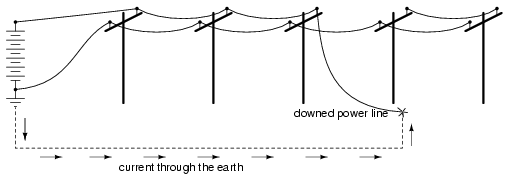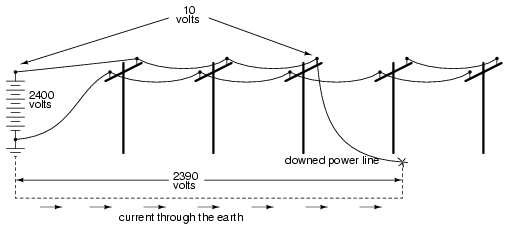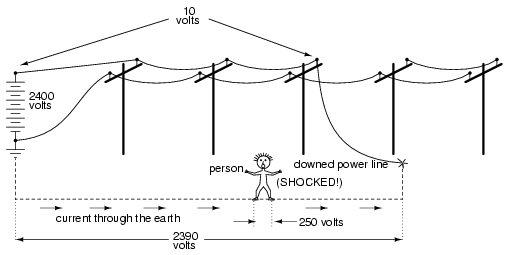Common sources of
hazard
Of course there is danger of electrical
shock when directly performing manual work on an electrical
power system. However, electric shock hazards exist in many
other places, thanks to the widespread use of electric power
in our lives.
As we saw earlier, skin and body resistance
has a lot to do with the relative hazard of electric
circuits. The higher the body's resistance, the less likely
harmful current will result from any given amount of
voltage. Conversely, the lower the body's resistance, the
more likely for injury to occur from the application of a
voltage.
The easiest way to decrease skin resistance
is to get it wet. Therefore, touching electrical devices
with wet hands, wet feet, or especially in a sweaty
condition (salt water is a much better conductor of
electricity than fresh water) is dangerous. In the
household, the bathroom is one of the more likely places
where wet people may contact electrical appliances, and so
shock hazard is a definite threat there. Good bathroom
design will locate power receptacles away from bathtubs,
showers, and sinks to discourage the use of appliances
nearby. Telephones that plug into a wall socket are also
sources of hazardous voltage (the ringing signal in a
telephone is 48 volts AC -- remember that any voltage over
30 is considered potentially dangerous!). Appliances such as
telephones and radios should never, ever be used while
sitting in a bathtub. Even battery-powered devices should be
avoided. Some battery-operated devices employ
voltage-increasing circuitry capable of generating lethal
potentials.
Swimming pools are another source of
trouble, since people often operate radios and other powered
appliances nearby. The National Electrical Code requires
that special shock-detecting receptacles called Ground-Fault
Current Interrupting (GFI or GFCI) be installed in wet and
outdoor areas to help prevent shock incidents. More on these
devices in a later section of this chapter. These special
devices have no doubt saved many lives, but they can be no
substitute for common sense and diligent precaution. As with
firearms, the best "safety" is an informed and conscientious
operator.
Extension cords, so commonly used at home
and in industry, are also sources of potential hazard. All
cords should be regularly inspected for abrasion or cracking
of insulation, and repaired immediately. One sure method of
removing a damaged cord from service is to unplug it from
the receptacle, then cut off that plug (the "male" plug)
with a pair of side-cutting pliers to ensure that no one can
use it until it is fixed. This is important on jobsites,
where many people share the same equipment, and not all
people there may be aware of the hazards.
Any power tool showing evidence of
electrical problems should be immediately serviced as well.
I've heard several horror stories of people who continue to
work with hand tools that periodically shock them. Remember,
electricity can kill, and the death it brings can be
gruesome. Like extension cords, a bad power tool can be
removed from service by unplugging it and cutting off the
plug at the end of the cord.
Downed power lines are an obvious source of
electric shock hazard and should be avoided at all costs.
The voltages present between power lines or between a power
line and earth ground are typically very high (2400 volts
being one of the lowest voltages used in residential
distribution systems). If a power line is broken and the
metal conductor falls to the ground, the immediate result
will usually be a tremendous amount of arcing (sparks
produced), often enough to dislodge chunks of concrete or
asphalt from the road surface, and reports rivaling that of
a rifle or shotgun. To come into direct contact with a
downed power line is almost sure to cause death, but other
hazards exist which are not so obvious.
When a line touches the ground, current
travels between that downed conductor and the nearest
grounding point in the system, thus establishing a circuit:

The earth, being a conductor (if only a poor
one), will conduct current between the downed line and the
nearest system ground point, which will be some kind of
conductor buried in the ground for good contact. Being that
the earth is a much poorer conductor of electricity than the
metal cables strung along the power poles, there will be
substantial voltage dropped between the point of cable
contact with the ground and the grounding conductor, and
little voltage dropped along the length of the cabling (the
following figures are very approximate):

If the distance between the two ground
contact points (the downed cable and the system ground) is
small, there will be substantial voltage dropped along short
distances between the two points. Therefore, a person
standing on the ground between those two points will be in
danger of receiving an electric shock by intercepting a
voltage between their two feet!

Again, these voltage figures are very
approximate, but they serve to illustrate a potential
hazard: that a person can become a victim of electric shock
from a downed power line without even coming into contact
with that line!
One practical precaution a person could take
if they see a power line falling towards the ground is to
only contact the ground at one point, either by running away
(when you run, only one foot contacts the ground at any
given time), or if there's nowhere to run, by standing on
one foot. Obviously, if there's somewhere safer to run,
running is the best option. By eliminating two points of
contact with the ground, there will be no chance of applying
deadly voltage across the body through both legs.
-
REVIEW:
-
Wet conditions increase risk of electric
shock by lowering skin resistance.
-
Immediately replace worn or damaged
extension cords and power tools. You can prevent innocent
use of a bad cord or tool by cutting the male plug off the
cord (while it's unplugged from the receptacle, of
course).
-
Power lines are very dangerous and should
be avoided at all costs. If you see a line about to hit
the ground, stand on one foot or run (only one foot
contacting the ground) to prevent shock from voltage
dropped across the ground between the line and the system
ground point.
|